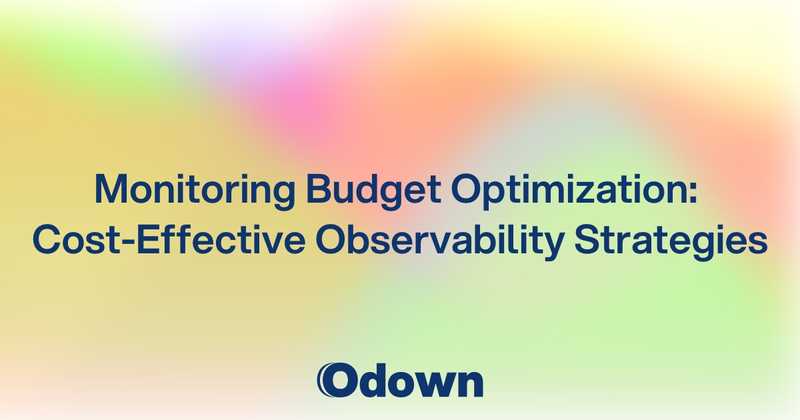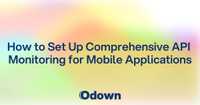Monitoring Budget Optimization: Cost-Effective Observability Strategies
Your monitoring bills keep growing faster than your infrastructure. What started as a modest investment in uptime monitoring has evolved into a sprawling collection of tools that consume an increasingly large portion of your technology budget. Log aggregation costs spike unpredictably. APM tools charge based on data ingestion that scales faster than business value. Multiple monitoring platforms create overlapping capabilities that duplicate costs without providing proportional benefits.
Meanwhile, budget pressure forces difficult decisions: reduce monitoring coverage to control costs, or maintain comprehensive visibility at the expense of other technology investments. Neither option feels acceptable when monitoring protects revenue and customer experience, but monitoring costs shouldn't consume budgets that could drive business growth.
Smart monitoring budget optimization balances comprehensive observability with cost efficiency through strategic tool selection, intelligent data management, and focused monitoring that maximizes business value per dollar spent. The goal isn't to minimize monitoring costs, but to optimize monitoring value while controlling expenses that threaten overall technology budget health.
Understanding Monitoring Cost Drivers
Effective budget optimization requires understanding the specific factors that drive monitoring expenses and identifying opportunities for cost reduction without compromising operational effectiveness.
Data Volume and Retention Costs
Data-related costs often represent the largest and most unpredictable component of monitoring expenses, especially for platforms that charge based on data ingestion or storage volume.
Log Data Explosion: Application logs generate enormous data volumes that increase faster than business growth. Debug logging left enabled in production, chatty application frameworks, and verbose error messages can multiply log data costs without providing proportional monitoring value.
Modern applications often generate gigabytes of log data daily per service, creating monthly costs that can reach thousands of dollars for log aggregation platforms that charge based on data volume.
Metrics Proliferation: Custom metrics and high-cardinality data create exponential cost growth in time-series databases. Applications that track metrics with many unique labels or dimensions can generate millions of metric data points that dramatically increase monitoring platform costs.
Monitoring platforms that charge based on custom metrics or data points can create budget surprises when application changes introduce new metrics or increase metric cardinality without corresponding business value.
Trace Data Volume: Distributed tracing generates detailed data about request flows through complex applications. High trace sampling rates or long trace retention periods can create substantial storage and processing costs that might exceed the value of detailed trace analysis.
Historical Data Retention: Long-term data retention for compliance or analysis purposes creates ongoing storage costs that accumulate over time. Many organizations retain monitoring data longer than necessary due to unclear retention policies or fear of losing historical context.
Platform and Tool Sprawl
Multiple monitoring tools create overlapping capabilities and administrative overhead that multiplies costs without providing proportional value.
Redundant Capabilities: Organizations often use multiple tools with overlapping features, paying for similar capabilities across different platforms. Infrastructure monitoring, APM, and log management tools frequently provide redundant alerting, dashboarding, and data analysis features.
Vendor Lock-in Costs: Some monitoring platforms use pricing strategies that make migration expensive, leading to continued use of suboptimal tools due to switching costs rather than ongoing value.
Integration Complexity: Multiple monitoring tools require integration infrastructure and administrative overhead that creates hidden costs beyond subscription fees. Custom dashboards, alert correlation, and data export functionality require ongoing maintenance that consumes team resources.
License Optimization: Many monitoring platforms offer various licensing models and feature tiers that organizations don't optimize regularly. Teams often pay for advanced features or higher service levels than their actual monitoring requirements justify.
Resource and Infrastructure Overhead
Self-hosted monitoring components and infrastructure requirements create ongoing costs that extend beyond monitoring platform subscriptions.
Self-Hosted Infrastructure: Organizations running Prometheus, Grafana, or other self-hosted monitoring tools often underestimate infrastructure costs including servers, storage, networking, and operational overhead required for reliable monitoring operations.
Geographic Distribution: Global monitoring capabilities require infrastructure or service costs across multiple regions. Organizations serving global customers need monitoring coverage that reflects user distribution, but global monitoring capabilities often multiply infrastructure or subscription costs.
High Availability Requirements: Monitoring system reliability often requires redundant infrastructure and operational procedures that increase costs beyond basic monitoring capabilities. Monitoring system failures during incidents create double failures that justify reliability investment but increase overall monitoring costs.
Strategic Tool Selection and Consolidation
Optimizing monitoring budgets requires strategic decisions about tool selection that balance comprehensive observability with cost efficiency and operational simplicity.
Monitoring Platform Consolidation
Reducing tool sprawl through platform consolidation can significantly reduce both subscription costs and operational overhead.
Overlapping Feature Analysis: Audit current monitoring tools to identify overlapping capabilities and consolidation opportunities. Many organizations discover they're paying for similar alerting, dashboarding, or data analysis features across multiple platforms that could be consolidated into fewer tools.
Consolidation analysis should consider not just feature overlap, but also integration complexity and data correlation capabilities that might justify maintaining separate specialized tools.
All-in-One vs. Best-of-Breed: Evaluate whether comprehensive monitoring platforms provide better value than specialized tools for your specific requirements. All-in-one platforms can reduce total costs through bundled pricing and eliminated integration overhead, but might provide inferior capabilities in specific monitoring domains.
The decision between platform consolidation and specialized tools depends on team expertise, integration requirements, and the specific monitoring capabilities that drive business value for your applications.
Migration Planning: Successful platform consolidation requires careful migration planning that maintains monitoring coverage during transitions. Migration costs and risks must be weighed against long-term cost savings and operational improvements from reduced tool sprawl.
Cost-Effective Tool Selection
Choosing monitoring tools based on value-per-dollar rather than just feature breadth helps optimize monitoring budgets while maintaining operational effectiveness.
Pricing Model Evaluation: Different monitoring platforms use various pricing models including per-host, per-user, data volume, or feature-based pricing. Understanding how different pricing models affect total cost as your infrastructure scales helps predict long-term budget requirements.
Some pricing models favor specific usage patterns or organization sizes. Teams should choose platforms with pricing models that align with their growth patterns and monitoring usage characteristics.
Feature-to-Cost Analysis: Evaluate monitoring tools based on essential feature requirements rather than comprehensive feature lists. Many organizations pay for advanced features that provide minimal value while underinvesting in basic monitoring capabilities that drive real business value.
Focus monitoring tool selection on capabilities that directly support incident response, performance optimization, and business outcome correlation rather than impressive feature lists that might go unused.
Open Source Integration: Consider open source monitoring tools for specific use cases where commercial platforms don't provide sufficient value to justify their costs. Open source tools require operational investment but can provide cost advantages for organizations with appropriate technical expertise.
Successful open source monitoring implementations require realistic assessment of operational overhead and expertise requirements that affect total cost of ownership beyond licensing savings.
Right-Sizing Monitoring Coverage
Optimizing monitoring scope ensures comprehensive coverage of business-critical services while avoiding over-monitoring of less important systems.
Business Impact Prioritization: Focus monitoring investment on services and systems that directly affect customer experience and business revenue. Not all applications and infrastructure components require the same level of monitoring sophistication or coverage.
Prioritization frameworks should consider customer impact, revenue contribution, and operational criticality when allocating monitoring budget across different services and systems.
Monitoring Tier Strategy: Implement different monitoring levels for different service tiers. Business-critical services might justify comprehensive APM and detailed alerting, while development environments might only need basic uptime monitoring.
Tiered monitoring strategies help optimize costs by matching monitoring investment to business value while maintaining comprehensive coverage of essential systems.
Environment-Specific Monitoring: Production environments typically require comprehensive monitoring, while development and testing environments might need only basic monitoring capabilities. Avoiding over-monitoring of non-production environments can provide significant cost savings.
Data Management and Retention Optimization
Intelligent data management significantly reduces monitoring costs while preserving essential observability capabilities and historical analysis requirements.
Log Data Optimization
Log management often represents the largest cost component in monitoring budgets, making log optimization a high-impact cost reduction opportunity.
Log Level Management: Implement dynamic log level management that reduces verbose logging in production environments while maintaining detailed logging capability for troubleshooting scenarios. Many applications log debug information in production that provides minimal operational value but creates substantial data costs.
Structured logging frameworks that enable runtime log level adjustment can reduce log volume significantly without requiring application changes or redeployment.
Log Sampling and Filtering: Implement intelligent log sampling that captures representative log data without storing every log message. Sampling strategies should preserve error logs and anomalous events while reducing volume of routine operational logs.
Application-level log filtering can eliminate logs that provide minimal operational value, such as successful health check responses or routine background job completions that don't require persistent storage.
Log Lifecycle Management: Implement automated log retention policies that archive or delete old log data based on operational value and compliance requirements. Many organizations retain all log data indefinitely due to unclear retention policies rather than actual analysis requirements.
Hot-warm-cold storage strategies can reduce log storage costs by moving older logs to cheaper storage tiers while maintaining accessibility for historical analysis when needed.
Metrics and Time-Series Optimization
Time-series data from metrics monitoring can create substantial costs when cardinality and retention aren't managed strategically.
Cardinality Management: High-cardinality metrics with many unique label combinations create exponential data volume growth. Implement metrics design guidelines that avoid unnecessary labels and use appropriate granularity for different monitoring use cases.
Metric cardinality should be evaluated regularly as applications evolve and new metrics are added. Unused or low-value metrics should be eliminated to prevent data volume growth that doesn't provide proportional monitoring value.
Metric Sampling: Implement intelligent metric sampling for non-critical monitoring data while maintaining full resolution for business-critical metrics. Some performance metrics might not require second-by-second resolution but can be sampled at lower frequencies.
Aggregation Strategies: Use metric aggregation and rollup policies that maintain essential monitoring capabilities while reducing long-term storage requirements. Historical data can often be aggregated into summary statistics without losing operationally relevant information.
Trace Data Management
Distributed tracing provides valuable insights but can generate enormous data volumes that require careful management to control costs.
Intelligent Sampling: Implement trace sampling strategies that capture representative request patterns without storing every trace. Sampling should prioritize error traces, slow requests, and unusual execution patterns while reducing volume of routine successful requests.
Head-based sampling at application ingress can reduce trace data volume, while tail-based sampling enables more sophisticated sampling decisions based on complete trace characteristics.
Retention Optimization: Most trace data loses operational value quickly after collection. Implement short retention periods for detailed trace data while maintaining longer retention for aggregated trace analytics and trend analysis.
Trace Data Summarization: Extract key performance metrics and error patterns from detailed trace data, then store summarized insights rather than complete trace details for long-term analysis.
Alternative Monitoring Approaches
Cost optimization sometimes requires rethinking monitoring approaches rather than just optimizing existing tool configurations.
Hybrid Monitoring Strategies
Combining different monitoring approaches can provide comprehensive observability at lower total cost than purely commercial or purely open source strategies.
Commercial-Open Source Mix: Use commercial platforms for business-critical monitoring where reliability and support justify costs, while implementing open source solutions for less critical monitoring scenarios where operational overhead is acceptable.
This hybrid approach enables cost optimization while maintaining professional monitoring capabilities for essential business services.
Internal Tool Development: For organizations with appropriate expertise, developing custom monitoring tools for specific use cases can provide cost advantages over commercial platforms with extensive features that exceed actual requirements.
Custom monitoring development requires realistic assessment of development and maintenance costs compared to commercial platform subscription fees.
Cloud Native Monitoring: Leverage cloud provider monitoring services for infrastructure hosted on those platforms. Cloud provider monitoring often provides cost advantages and deeper integration for services running on the same cloud platform.
Monitoring-as-Code and Automation
Automation can reduce monitoring operational overhead while improving monitoring effectiveness and cost efficiency.
Infrastructure as Code: Implement monitoring configuration through infrastructure as code practices that reduce manual monitoring setup and maintenance overhead. Automated monitoring deployment reduces operational costs and improves monitoring consistency.
Alert Optimization: Use automation to optimize alert configurations and reduce false positives that consume team time and reduce operational efficiency. Alert fatigue reduces monitoring value while consuming resources for alert management.
Capacity Right-Sizing: Implement automated monitoring of monitoring infrastructure itself to optimize resource allocation and prevent over-provisioning of monitoring systems.
Business Value Correlation
Focus monitoring investment on capabilities that directly correlate with business outcomes rather than comprehensive technical coverage.
Revenue Impact Monitoring: Prioritize monitoring capabilities that track services directly affecting revenue generation and customer experience. Not all technical metrics provide equivalent business value.
Customer Experience Focus: Concentrate monitoring investment on user-facing services and performance characteristics that customers actually experience rather than internal technical metrics that might not affect user satisfaction.
Operational Efficiency: Evaluate monitoring tools based on their contribution to operational efficiency and incident response effectiveness rather than just technical capability breadth.
Monitoring budget optimization transforms monitoring from a cost center into a strategic investment that protects business value while controlling expenses. The goal isn't to minimize monitoring costs, but to maximize business protection and operational effectiveness per dollar spent on monitoring capabilities.
Successful optimization requires understanding cost drivers, making strategic tool choices, implementing intelligent data management, and focusing monitoring investment on capabilities that provide the highest business value. Organizations that optimize monitoring budgets effectively often achieve better observability outcomes at lower costs than organizations that pursue comprehensive monitoring without cost consideration.
Ready to optimize your monitoring budget without compromising reliability? Odown provides cost-effective monitoring with transparent pricing and comprehensive capabilities that eliminate the need for multiple monitoring tools while protecting your services and controlling your monitoring expenses.



